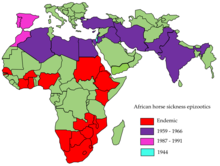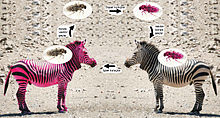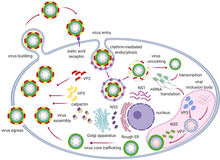| African horse sickness virus | |
|---|---|
|
Virus classification
| |
| (unranked): | Virus |
| Realm: | Riboviria |
| Kingdom: | Orthornavirae |
| Phylum: | Duplornaviricota |
| Class: | Resentoviricetes |
| Order: | Reovirales |
| Family: | Sedoreoviridae |
| Genus: | Orbivirus |
| Species: | African horse sickness virus
|
African horse sickness (AHS) is a highly infectious and often fatal disease caused by African horse sickness virus. It commonly affects horses, mules, and donkeys. It is caused by a virus of the genus Orbivirus belonging to the family Reoviridae. This disease can be caused by any of the nine serotypes of this virus. AHS is not directly contagious, but is known to be spread by insect vectors.
Epidemiology

AHS virus was first recorded south of the Sahara Desert in the mid-1600s, with the introduction of horses to southern Africa. The virus is considered endemic to the equatorial, eastern, and southern regions of Africa. Several outbreaks have occurred in the Equidae throughout Africa and elsewhere. [2] AHS is known to be endemic in sub-Saharan Africa, and has spread to Morocco, the Middle East, India, and Pakistan. More recently, outbreaks have been reported in the Iberian Peninsula and Thailand. AHS has never been reported in the Americas, eastern Asia, or Australasia. Epidemiology is dependent on host-vector interaction, where cyclic disease outbreaks coincide with high numbers of competent vectors. The most important vector for AHS in endemic areas is the biting midge Culicoides imicola, which prefers warm, humid conditions. Larvae do not carry the virus, and long, cold winters are sufficient to break epidemics in nonendemic areas.[ citation needed]
Host
The common hosts of this disease are horses, mules, donkeys, and zebras. However, elephants, camels, and dogs can be infected, as well, but often show no signs of the disease and it is very rare. Dogs usually contract the disease by eating infected horse meat, although a recent report has been made of the disease occurring in dogs with no known horse-meat ingestion. [3]
Transmission

This disease is spread by insect vectors. The biological vector of the virus is the Culicoides (midges) species, but this disease can also be transmitted by species of mosquitoes including Culex, Anopheles, and Aedes including A. aegypti, [4] and species of ticks such as Hyalomma and Rhipicephalus.
Clinical signs
Horses are the most susceptible host with close to 90% [5] [6] mortality of those affected, followed by mules (50%) and donkeys (10%). African donkeys and zebras very rarely display clinical symptoms, despite high virus titres in blood, and are thought to be the natural reservoir of the virus. AHS manifests itself in four different forms:
Pulmonary form
The peracute form of the disease is characterized by high fever, depression, and respiratory symptoms. The clinically affected animal has trouble breathing, starts coughing frothy fluid from nostril and mouth, and shows signs of pulmonary edema within four days. Serious lung congestion causes respiratory failure and results in death in under 24 hours. This form of the disease has the second highest mortality rate. Other symptoms include swelling of the lymph nodes under the jaw, and levelled swelling above the eyes. This form does not have as much swelling on the brain as the Cardiac form, the swelling is mostly around the organs[ citation needed]
Cardiac form

This subacute form of the disease has an incubation period longer than that of the pulmonary form. Signs of disease start at day 7–12 after infection. High fever is a common symptom. The disease also manifests as conjunctivitis, with abdominal pain and progressive dyspnea. Additionally, edema is presented under the skin of the head and neck, most notably in swelling of the supraorbital fossae, palpebral conjunctiva, and intermandibular space. Mortality rate is between 50 and 70%, and survivors recover in 7 days. This form does not have such a high mortality rate, but the lymph nodes and above the eyes are not as swelled. The swelling above the eyes are a sign that the brain is swollen, and if it is too much the eyes will pop out. If treated correctly the animals has a higher chance of surviving.
Mild or horse sickness fever form
Mild to subclinical disease is seen in zebras and African donkeys. Infected animals may have a low-grade fever and congested mucous membrane. The survival rate is 100%.
Mixed form
Diagnosis is made at necropsy. Affected horses show signs of both the pulmonary and cardiac forms of AHS. This form probably has the highest mortality rate of all the forms. Not many survive this.
Diagnosis
Presumptive diagnosis is made by characteristic clinical signs, post mortem lesions, and presence of competent vectors. Laboratory confirmation is by viral isolation, with such techniques as quantitative PCR for detecting viral RNA, antigen capture ( ELISA), and immunofluorescence of infected tissues. Serological tests are only useful for detecting recovered animals, as sick animals die before they are able to mount effective immune responses.[ citation needed]
Treatment and prevention
No treatment for AHS is known. [7]
Control of an outbreak in an endemic region involves quarantine, vector control, and vaccination. [8] To prevent this disease, the affected horses are usually slaughtered, and the uninfected horses are vaccinated against the virus. [9] Three vaccines currently exist, which include a polyvalent vaccine, a monovalent vaccine, and a monovalent inactivated vaccine.[ citation needed] This disease can also be prevented by destroying the insect vector habitats and by using insecticides.[ citation needed]
History
African horse sickness was diagnosed in Spain in 1987–90 and in Portugal in 1989, but was eradicated using slaughter policies, movement restrictions, vector eradication, and vaccination. [5]
Infection was reported in Pak Chong district of Nakhon Ratchasima province in Thailand in March 2020 when 42 racehorses died from an unknown illness which was later confirmed to be African Horse Sickness virus serotype 1. [10]
Related diseases
AHS is related to bluetongue disease and is spread by the same midge ( Culicoides species).[ citation needed]
References
- ^ "ICTV 9th Report (2011) Reoviridae" (html). International Committee on Taxonomy of Viruses (ICTV). Retrieved 17 January 2019.
- ^ CIDRAP >> African Horse Sickness Archived July 12, 2010, at the Wayback Machine
- ^ Van Sittert; et al. (2013). "Occurrence of African horse sickness in a domestic dog without apparent ingestion of horse meat". Journal of the South African Veterinary Association. 84 (1): 5. doi: 10.4102/jsava.v84i1.948. hdl: 2263/36753.
- ^ Carpenter, Simon; Mellor, Philip S.; Fall, Assane G.; Garros, Claire; Venter, Gert J. (2017-01-31). "African Horse Sickness Virus: History, Transmission, and Current Status". Annual Review of Entomology. 62 (1). Annual Reviews: 343–358. doi: 10.1146/annurev-ento-031616-035010. ISSN 0066-4170. PMID 28141961.
- ^ a b "Lethal horse disease knocking on Europe's door" (Press release). Unknown. 2007-03-28. Retrieved 2007-03-27.
- ^ The Merck Veterinary Manual – African Horse Sickness – Clinical Findings and Lesions
- ^ "AFRICAN HORSE SICKNESS" (PDF). OIE - World Organisation for Animal Health. OIE - World Organisation for Animal Healthwww.oie.int. Retrieved 29 June 2020.
- ^ "African Horse Sickness". Animal Research Info. Retrieved 29 June 2020.
- ^ "African Horse Sickness" (PDF). Iowa State University. Retrieved 29 June 2020.
- ^ King, Simon (27 June 2020). "Outbreak of African horse sickness in Thailand, 2020". Transboundary and Emerging Diseases. 67 (5): 1764–1767. doi: 10.1111/tbed.13701. PMID 32593205. S2CID 220130174.
External links
- Disease card from the World Organisation for Animal Health (OIE)
- Current status of African Horse Sickness worldwide at World Organisation for Animal Health (OIE). WAHID Interface – OIE World Animal Health Information Database
- CIDRAP Overview on African Horse Sickness
- 3D electron microscopy structures of the African horse sickness virus from the EM Data Bank(EMDB)
- The role of conserved residues in African horsesickness virus protein NS3 in intracellular localisation and cytotoxicity